Table of Contents
Risk of Vehicle Rolling Transmission Not in P (Mercedes): Why It Matters & How to Fix It
A “Transmission Not in P Risk of Vehicle Rolling Away” warning means your Mercedes cannot confirm the gearbox is safely in Park. That’s a serious safety flag: on an incline or with passengers loading, an unsecure vehicle can roll. While owners often suspect a gearbox fault, the root cause is frequently communication and power issues (ESP/ESC, parking brake circuit, door-latch sensors, or gear-selector signal path) rather than the transmission itself.
This guide explains how the system works, what fails, and a step-by-step diagnostic flow, then walks through a real W205 case study where fixing ESP communication and a blown parking-brake fuse (#210) cleared the warning.
Quick Snapshot (What to Know First)
- – The car shows the warning when modules don’t agree that Park is engaged.
- – Common culprits: ESP/ESC module faults, blown fuse in the parking-brake feed, door-latch switch misreads, gear-selector (ESM) signal not reaching the TCU/cluster.
- – Always use the parking brake while the fault is active. Diagnose before daily driving.
Symptoms & Common Causes (Fast Triage)
| Cause | Typical Symptoms | Quick Checks & Likely Fix |
|---|---|---|
| ESP/ESC communication fault | “Risk of vehicle rolling” persists even in Park; other ESC/ABS messages | Full scan; if comm/DTCs present → reprogram or replace module, then calibrations |
| Blown parking-brake fuse (e.g., #210)* | ESP/parking-brake warnings after selecting Park; EPB inoperative | Inspect/replace the fuse; investigate why it blew (short, water ingress) |
| Door latch / door-ajar switch | Warning appears with driver door open or during start/exit | Close doors firmly; test latch switch status; replace faulty latch |
| Gear selector / range signal path | Cluster shows “Not in P” though lever is in P | Scan for selector/TCU codes; verify selector input and CAN path |
| Low system voltage | Intermittent cluster warnings, random comm faults | Battery/charging test; fix weak battery or grounds |
*Fuse number/location may vary by VIN confirm in WIS/ASRA.
Diagnostic & Repair Flow (Do This in Order)
- 1. Secure the car: Engage P and parking brake. Use chocks on an incline.
- 2. Close all doors (start with the driver’s). Many models inhibit logic if a door is ajar.
- 3. OE-level scan (XENTRY): Pull codes in ESP/ESC, TCU/EGS, Instrument Cluster, EPB, and SAM modules. Save freeze frames.
- 4. Power & fuse check: Test battery/alternator and inspect fuse(s) for EPB/ESP (e.g., #210, driver-side cover on the W205 case). Replace blown fuses and address the source (short, moisture).
- 5. Module communication: If ESP/ESC has comm faults, repair/replace the unit and perform coding/calibration (yaw/steering angle, longitudinal acceleration as applicable).
- 6. Door-latch sensors: Read live data for driver door status; replace latches that flicker/open when closed.
- 7. Gear-selector validation: Confirm range “P” reaches the TCU and cluster (actual values). If not, inspect selector wiring/CAN lines.
- 8. Clear DTCs & retest on level ground; confirm no warning returns.
- 9. Final safety check: Verify EPB holds on an incline and the vehicle reports P consistently after cycling ignition.
Case Study: W205 C-Class (2016): “Transmission Not in P: Risk of Vehicle Rolling”
Complaint: Persistent cluster warning; car fails to acknowledge Park.
Background: Vehicle had prior collision damage.
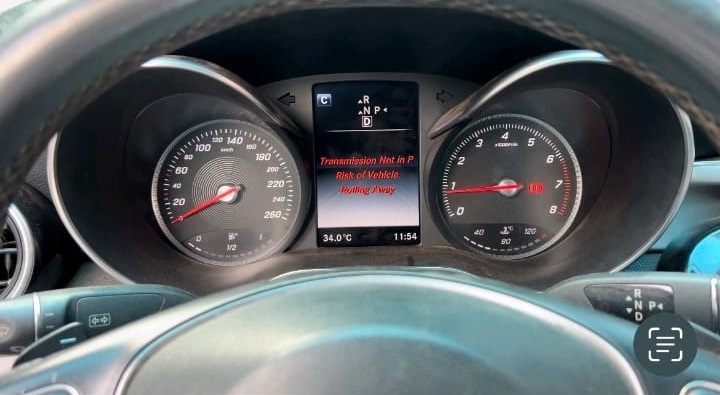
Findings & Fix
=> ESP/ESC DTCs & communication issue traced to collision damage.
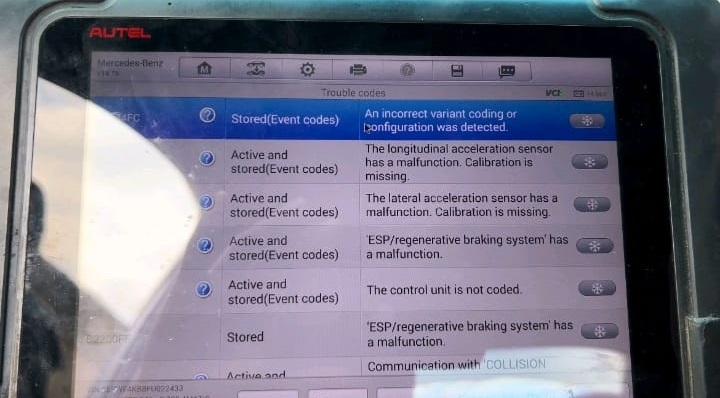
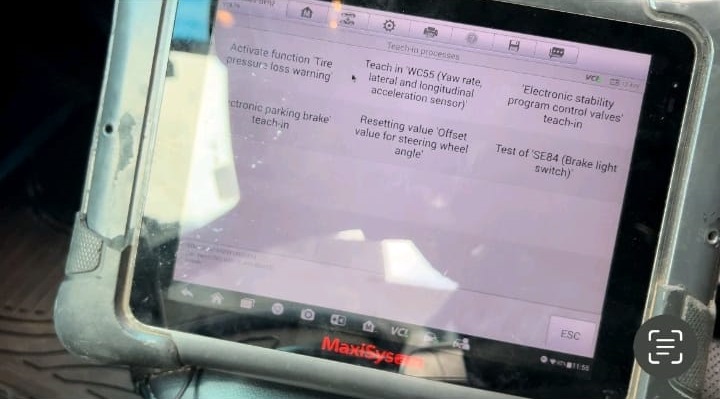
=> The ESP/ESC unit was replaced and coded/calibrated.

=> A new message appeared: ESP/Regenerative braking malfunction.

=> Investigation found fuse #210 blown (driver-side cover). That fuse feeds the parking-brake circuit.
=> Fuse replaced (do not drive with a “bridge” temporary bridging is for controlled diagnostics only), wiring inspected, moisture source addressed.
=> After clearing faults and repeating calibrations, Park status recognized, EPB worked, and the warning was gone. Extended test confirmed normal operation.
Lesson: Roll-away warnings can be network/power integrity problems, not transmission failure. Fixing module communication and EPB power restored Park confirmation.
Role of Key Components
| Component | What It Does for “P” | Failure Impact |
|---|---|---|
| ESP/ESC | Shares vehicle-state data (speed, standstill, driver actions) with cluster/TCU | Comm loss can block Park confirmation |
| EPB (Electric Parking Brake) | Holds the car mechanically; status feeds cluster logic | Fuse or actuator faults trigger warnings |
| Door-latch switch | Confirms driver door closed (safety logic) | Ajar reading can force warnings when not in P |
| Gear selector/ESM | Sends range “P” to TCU/cluster via CAN | Signal loss = “Not in P” despite lever position |
| TCU/EGS | Validates and reports Park status to the network | TCU power/ground/comm faults block Park |
Explore More Mercedes Transmission Issues
For a deeper dive into gearbox problems slipping into Neutral, delayed/harsh shifts, “Not in P” warnings, and hybrid faults visit our hub: Mercedes Transmission Issues – Causes and Fixes. You’ll find grouped case studies, step-by-step diagnostics, symptom–cause–fix tables, and prevention tips to resolve shifting issues quickly and confidently.
DIY vs Professional Tasks
| Task | DIY-Friendly | Pro Recommended | Notes |
|---|---|---|---|
| Close doors, test warning behavior | OK | Quick rule-out for latch logic | |
| Battery/charging system test | OK | Low voltage = false comm errors | |
| Basic fuse check/replace | OK | Replace, not permanent bridging | |
| OE-level scan & coding/calibrations | OK | Needed after ESP/TCU work | |
| Door-latch replacement | OK | Coding/adjustment may be needed | |
| ESP/ESC replacement & setup | OK | Safety-critical; follow WIS | |
| Selector/TCU wiring/CAN repair | OK | Requires diagrams & CAN measurement |
Safety & Prevention Tips
- – Always use the parking brake even on level ground until the warning is fixed.
- – Keep battery and grounds healthy; low voltage triggers network chaos.
- – If you’ve had collision/water ingress, proactively inspect ESP/EPB wiring and SAM connectors.
- – After module or software updates, run calibrations (steering angle, longitudinal accel) as required.
- – Don’t ignore intermittent messages. Log them and scan early small electrical issues become big ones.
Park vs Neutral
| Park (P) | Neutral (N) | |
|---|---|---|
| What it does | Engages parking pawl that mechanically locks the transmission output | Disconnects engine from wheels; wheels free-rolling |
| Best use | Parking, loading/unloading, engine start (most models) | Short procedures (towing setup, some car-wash conveyors) |
| Roll-away risk | Minimal (still apply EPB) | High unless EPB is engaged |
| Engine start | Usually required | Often allowed, but not a secure state |
Bottom line: Use Park for any stationary scenario; Neutral only for short, specific tasks, and always apply the parking brake.

How “P” Actually Locks the Car
Inside the transmission, a parking pawl engages a toothed parking gear on the output shaft. If the pawl tip lands on a tooth, a spring keeps it preloaded until the next gap rotates under it, then it snaps into place. Design chamfers prevent engagement at higher speeds (the pawl is pushed away to avoid damage). That’s why you should be fully stopped before selecting Park.

FAQs: Risk of Vehicle Rolling Transmission Not in P
1) Can I drive with the “Risk of Vehicle Rolling” warning active?
Avoid it. The vehicle may not be secured in Park. Use the parking brake, park on level ground, and diagnose immediately.
2) Why does the warning appear only when I open the driver door?
Many models show the warning if the driver door opens while not in confirmed Park. A faulty door-latch switch can falsely trigger this logic.
3) My fuse was blown can I just replace it?
Yes, but find the root cause (short, water ingress, chafed wire). Do not drive with a bridged fuse. Bridging is for controlled diagnostics with current limiting only.
4) We replaced the transmission and the warning stayed. Why?
Because many cases are communication/power integrity issues (ESP/EPB/selector/CAN), not mechanical gearbox faults. Start with a scan and power/fuse check.
5) Do I need coding/calibration after ESC/ESP replacement?
Yes. Expect coding, steering-angle calibration, and sometimes additional sensor calibrations. Skipping these leaves warnings active.
6) Is the parking brake enough without “P”?
The EPB can hold the car, but Park adds a mechanical lock. For maximum safety, use both especially on slopes.
7) Does low battery really cause this?
Absolutely. Low voltage causes module resets and comm errors that can break Park confirmation. Check battery/charging first on modern vehicles.
Final Takeaway
“Risk of Vehicle Rolling Transmission Not in P” is not just a transmission problem. It’s usually a network/power validation problem: modules must agree that Park is engaged and the EPB can hold. In our W205 case, correcting ESP communication and replacing a blown EPB fuse (#210) restored Park confirmation and cleared the warning. Follow the scan → power/fuse → module comm → door latch → selector sequence, repair what you prove, and verify with a safe road test on level ground.
Note: Fuse IDs, procedures, and calibrations vary by VIN. Always confirm in Mercedes-Benz WIS/ASRA and observe safe workshop practices.
Author
Written by: Mercedes Expert
Automotive Technical Trainer & Mercedes-Benz Diagnostic Specialist
With years of hands-on experience repairing and diagnosing Mercedes-Benz vehicles, specializes in case-study-based troubleshooting guides that blend workshop accuracy with educational clarity.
Last Updated: September 2025

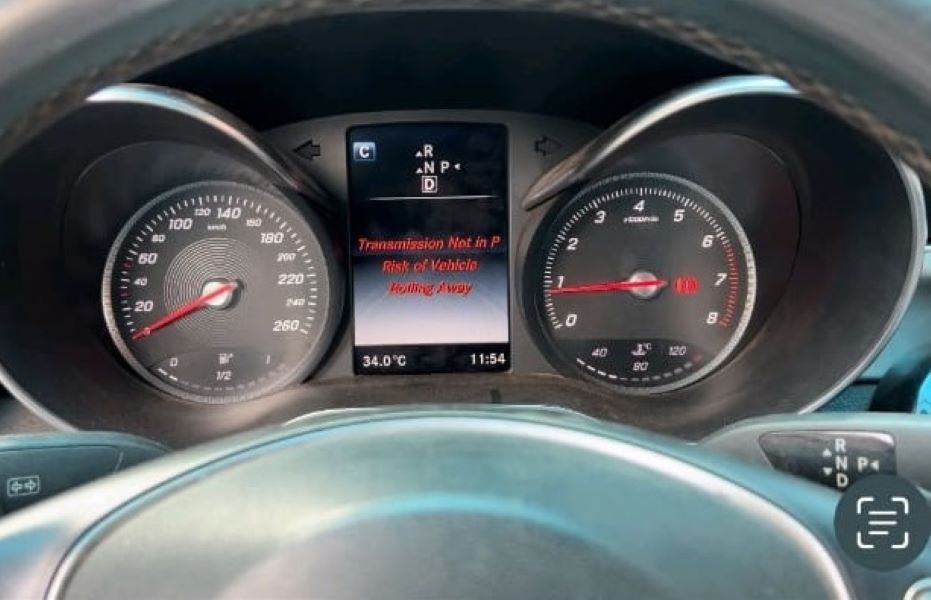
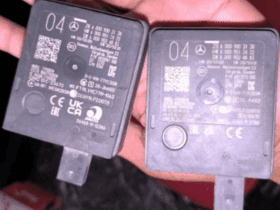
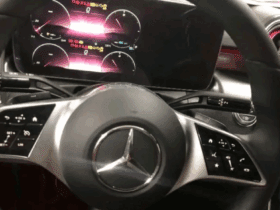
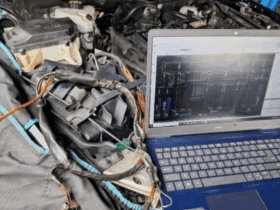
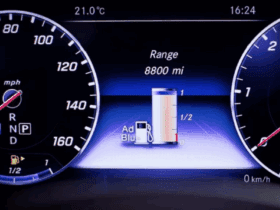
Leave a Reply